

Compact Muon Solenoid
LHC, CERN
| CMS-TOP-19-007 ; CERN-EP-2019-189 | ||
| Running of the top quark mass from proton-proton collisions at ${\sqrt{s}} = $ 13 TeV | ||
| CMS Collaboration | ||
| 19 September 2019 | ||
| Phys. Lett. B 803 (2020) 135263 | ||
| Abstract: The running of the top quark mass is experimentally investigated for the first time. The mass of the top quark in the modified minimal subtraction (${\mathrm{\overline{MS}}} $) renormalization scheme is extracted from a comparison of the differential top quark-antiquark ($\mathrm{t\bar{t}}$) cross section as a function of the invariant mass of the $\mathrm{t\bar{t}}$ system to next-to-leading-order theoretical predictions. The differential cross section is determined at the parton level by means of a maximum-likelihood fit to distributions of final-state observables. The analysis is performed using $\mathrm{t\bar{t}}$ candidate events in the $\mathrm{e}^{\pm}\mu^{\mp}$ channel in proton-proton collision data at a centre-of-mass energy of 13 TeV recorded by the CMS detector at the CERN LHC in 2016, corresponding to an integrated luminosity of 35.9 fb$^{-1}$. The extracted running is found to be compatible with the scale dependence predicted by the corresponding renormalization group equation. In this analysis, the running is probed up to a scale of the order of 1 TeV. | ||
| Links: e-print arXiv:1909.09193 [hep-ex] (PDF) ; CDS record ; inSPIRE record ; CADI line (restricted) ; | ||
| Figures & Tables | Summary | Additional Figures | References | CMS Publications |
|---|
| Figures | |
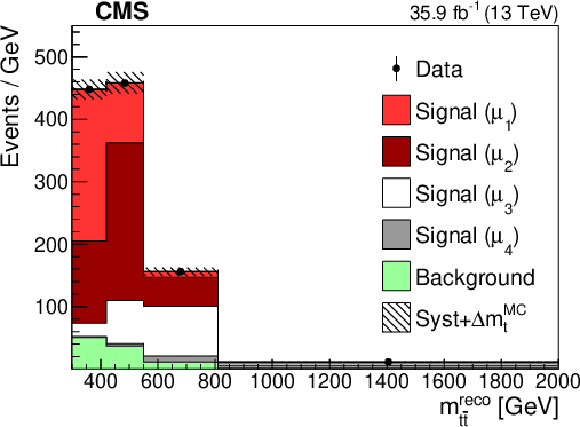
png pdf |
Figure 1:
Distribution of $ {m_{\mathrm{t} {}\mathrm{\bar{t}}} ^{\text {reco}}}$ after the fit to the data, with the same binning as used in the fit. The hatched band corresponds to the total uncertainty in the predicted yields and includes all correlations. The ${\mathrm{t} {}\mathrm{\bar{t}}}$ MC sample is split into four subsamples, denoted with "Signal $({\mu _k})$'', corresponding to bins of ${m_{\mathrm{t} {}\mathrm{\bar{t}}}}$ at the parton level. The first and last bins contain all events with $ {m_{\mathrm{t} {}\mathrm{\bar{t}}} ^{\text {reco}}} < $ 420 GeV and $ {m_{\mathrm{t} {}\mathrm{\bar{t}}} ^{\text {reco}}} > $ 810 GeV, respectively. |
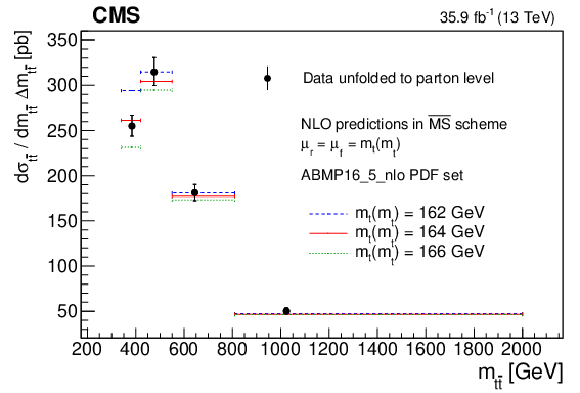
png pdf |
Figure 2:
Measured values of ${\sigma _{\mathrm{t} {}\mathrm{\bar{t}}} ^{(\mu _k)}}$ (markers) and their uncertainties (vertical error bars) compared to NLO predictions in the ${\mathrm {\overline {MS}}}$ scheme obtained with different values of ${{m_{\mathrm{t}}} ({m_{\mathrm{t}}})}$ (horizontal lines of different styles). The values of ${\sigma _{\mathrm{t} {}\mathrm{\bar{t}}} ^{(\mu _k)}}$ are shown at the representative scale of the process ${\mu _k}$, defined as the centre-of-gravity of the ${m_{\mathrm{t} {}\mathrm{\bar{t}}}}$ spectrum of each bin. The first and last bins contain all events with $ {m_{\mathrm{t} {}\mathrm{\bar{t}}}} < $ 420 GeV and $ {m_{\mathrm{t} {}\mathrm{\bar{t}}}} > $ 810 GeV, respectively. |
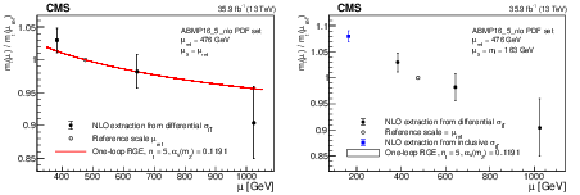
png pdf |
Figure 3:
Extracted running of the top quark mass $ {{m_{\mathrm{t}}} (\mu)} / {{m_{\mathrm{t}}} ({\mu _\text {ref}})} $ compared to the RGE prediction at one-loop precision ($ {n_f} = $ 5) evolved from the initial scale $\mu _0 = {\mu _\text {ref}} = $ 476 GeV (left). The result is compared to the value of $ {{m_{\mathrm{t}}} ^\text {incl}({m_{\mathrm{t}}})} / {{m_{\mathrm{t}}} ({\mu _\text {ref}})} $, where ${{m_{\mathrm{t}}} ^\text {incl}({m_{\mathrm{t}}})}$ is the value of ${{m_{\mathrm{t}}} ({m_{\mathrm{t}}})}$ extracted from the inclusive cross section measured in Ref. [14], which is based on the same data set. The uncertainty in ${{m_{\mathrm{t}}} ^\text {incl}({m_{\mathrm{t}}})}$ is evolved from the initial scale $\mu _0 = {m_{\mathrm{t}}} = $ 163 GeV using the same RGE prediction (right). |
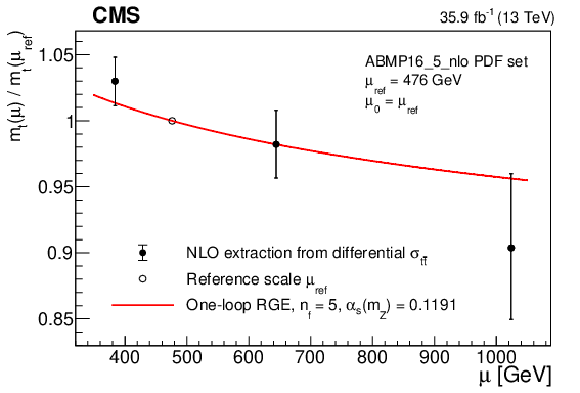
png pdf |
Figure 3-a:
Extracted running of the top quark mass $ {{m_{\mathrm{t}}} (\mu)} / {{m_{\mathrm{t}}} ({\mu _\text {ref}})} $ compared to the RGE prediction at one-loop precision ($ {n_f} = $ 5) evolved from the initial scale $\mu _0 = {\mu _\text {ref}} = $ 476 GeV. The result is compared to the value of $ {{m_{\mathrm{t}}} ^\text {incl}({m_{\mathrm{t}}})} / {{m_{\mathrm{t}}} ({\mu _\text {ref}})} $, where ${{m_{\mathrm{t}}} ^\text {incl}({m_{\mathrm{t}}})}$ is the value of ${{m_{\mathrm{t}}} ({m_{\mathrm{t}}})}$ extracted from the inclusive cross section measured in Ref. [14], which is based on the same data set. |

png pdf |
Figure 3-b:
The uncertainty in ${{m_{\mathrm{t}}} ^\text {incl}({m_{\mathrm{t}}})}$ is evolved from the initial scale $\mu _0 = {m_{\mathrm{t}}} = $ 163 GeV using the same RGE prediction. |
| Tables | |

png pdf |
Table 1:
Bins of ${m_{\mathrm{t} {}\mathrm{\bar{t}}}}$, the corresponding fraction of events in the {powheg} simulation, and the representative scale ${\mu _k}$. |
| Summary |
|
In this Letter, the first experimental investigation of the running of the top quark mass, ${m_{\mathrm{t}} }$, is presented. The running is extracted from a measurement of the differential top quark-antiquark ($\mathrm{t\bar{t}}$) cross section as a function of the invariant mass of the $\mathrm{t\bar{t}}$ system, $ {m_\mathrm{t\bar{t}}} $. The differential $\mathrm{t\bar{t}}$ cross section, ${{\mathrm{d}}{\sigma_\mathrm{t\bar{t}}} /{\mathrm{d}{m_\mathrm{t\bar{t}}}}} $, is determined at the parton level using a maximum-likelihood fit to distributions of final-state observables, using $\mathrm{t\bar{t}}$ candidate events in the $\mathrm{e}^{\pm}\mu^{\mp}$ channel. This technique allows the nuisance parameters to be constrained simultaneously with the differential cross section in the visible phase space and therefore provides results with significantly improved precision compared to conventional procedures in which the unfolding is performed as a separate step. The analysis is performed using proton-proton collision data at a centre-of-mass energy of 13 TeV recorded by the CMS detector at the CERN LHC in 2016, corresponding to an integrated luminosity of 35.9 fb$^{-1}$. The running mass ${m_{\mathrm{t}} (\mu)} $, as defined in the modified minimal subtraction ($ {\mathrm{\overline{MS}}} $) renormalization scheme, is extracted at next-to-leading order (NLO) as a function of $ {m_\mathrm{t\bar{t}}} $ by comparing fixed-order theoretical predictions at NLO to the measured ${{\mathrm{d}}{\sigma_\mathrm{t\bar{t}}} /{\mathrm{d}}{m_\mathrm{t\bar{t}}}} $. The extracted running of ${m_{\mathrm{t}} }$ is found to be in agreement with the prediction of the corresponding renormalization group equation, within {1.1} standard deviations, and the no-running hypothesis is excluded at above 95% confidence level. The running of ${m_{\mathrm{t}} }$ is probed up to a scale of the order of 1 TeV. |
| Additional Figures | |
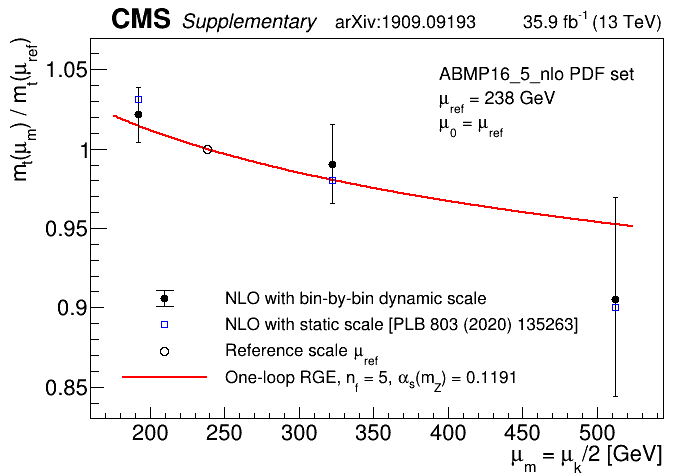
png pdf |
Additional Figure 1:
Extracted running of the top quark mass $m_{\mathrm{t}}(\mu_{m})/m_{\mathrm{t}}(\mu_{\text{ref}})$ (dots) compared to the one-loop solution of the corresponding renormalization group equation (RGE, line), assuming five active quark flavours ($n_{f} = $ 5), calculated from the initial scale $\mu_{0} = \mu_{\text{ref}} = $ 238 GeV (hollow dot). In the calculation, the scale $\mu_{m}$ is set to $ \mu_{k} $/2, where $\mu_{k}$ is the centre-of-gravity of the $m_{\mathrm{t\bar{t}}}$ distribution in bin $k$, as defined in Phys. Lett. B 803 (2020) 135263. In this way, $\mu_{m}$ is set independently in each bin of $m_{\mathrm{t\bar{t}}}$ and the value of $m_{\mathrm{t}}(\mu_{k}/2)$ is extracted directly. The values of $\mu_{\text{r}}$ and $\mu_{\text{f}}$ are both set to $m_{\mathrm{t}}(\mu_{m})$. The best-fit value of the parameter $x$ in Eq. 3 of Phys. Lett. B 803 (2020) 135263 is found to be $\hat{x} = $ 1.57 $\pm$ 0.57 (fit) $^{+0.28}_{-0.53}$ (PDF + $\alpha_{\text{S}}$) $^{+0.21}_{-0.46}$ (extr), in good agreement with the RGE prediction, which corresponds to $x =$ 1. The no-running hypothesis, corresponding to $ x =$ 0, is excluded at 96.2% confidence level. The extracted running is compared to the result presented in Phys. Lett. B 803 (2020) 135263, but with the choice of $\mu_{m}$ described above (hollow squares). |
| References | ||||
| 1 | A. Deur, S. J. Brodsky, and G. F. de Teramond | The QCD running coupling | Prog. Part. NP 90 (2016) 1 | 1604.08082 |
| 2 | CMS Collaboration | Measurement and QCD analysis of double-differential inclusive jet cross sections in pp collisions at $ \sqrt{s} = $ 8 TeV and cross section ratios to 2.76 and 7 TeV | JHEP 03 (2017) 156 | CMS-SMP-14-001 1609.05331 |
| 3 | P. A. Baikov, K. G. Chetyrkin, and J. H. Kuhn | Quark mass and field anomalous dimensions to $ {\cal O}(\alpha_{S}^5) $ | JHEP 10 (2014) 076 | 1402.6611 |
| 4 | T. Luthe, A. Maier, P. Marquard, and Y. Schroder | Five-loop quark mass and field anomalous dimensions for a general gauge group | JHEP 01 (2017) 081 | 1612.05512 |
| 5 | O. Behnke, A. Geiser, and M. Lisovyi | Charm, beauty and top at HERA | Prog. Part. NP 84 (2015) 1 | 1506.07519 |
| 6 | DELPHI Collaboration | Study of b-quark mass effects in multijet topologies with the DELPHI detector at LEP | EPJC 55 (2008) 525 | 0804.3883 |
| 7 | DELPHI Collaboration | Determination of the b quark mass at the $ M_{\mathrm{Z}} $ scale with the DELPHI detector at LEP | EPJC 46 (2006) 569 | |
| 8 | ALEPH Collaboration | A Measurement of the b quark mass from hadronic Z decays | EPJC 18 (2000) 1 | hep-ex/0008013 |
| 9 | OPAL Collaboration | Determination of the b quark mass at the Z mass scale | EPJC 21 (2001) 411 | hep-ex/0105046 |
| 10 | A. Brandenburg et al. | Measurement of the running b quark mass using $ \mathrm{e^{+}e^{-}} \to \mathrm{b\bar{b}} \mathrm{g} $ events | PLB 468 (1999) 168 | hep-ph/9905495 |
| 11 | ZEUS Collaboration | Measurement of beauty and charm production in deep inelastic scattering at HERA and measurement of the beauty-quark mass | JHEP 09 (2014) 127 | 1405.6915 |
| 12 | A. Gizhko et al. | Running of the charm-quark mass from HERA deep-inelastic scattering data | PLB 775 (2017) 233 | 1705.08863 |
| 13 | L. Mihaila | Precision calculations in supersymmetric theories | Adv. High Energy Phys. 2013 (2013) 607807 | 1310.6178 |
| 14 | CMS Collaboration | Measurement of the $ \mathrm{t\bar{t}} $ production cross section, the top quark mass, and the strong coupling constant using dilepton events in pp collisions at $ \sqrt{s} = $ 13 TeV | EPJC 79 (2019) 368 | CMS-TOP-17-001 1812.10505 |
| 15 | CMS Collaboration | The CMS trigger system | JINST 12 (2017) P01020 | CMS-TRG-12-001 1609.02366 |
| 16 | CMS Collaboration | The CMS experiment at the CERN LHC | JINST 3 (2008) S08004 | CMS-00-001 |
| 17 | CMS Collaboration | Particle-flow reconstruction and global event description with the CMS detector | JINST 12 (2017) P10003 | CMS-PRF-14-001 1706.04965 |
| 18 | CMS Collaboration | Performance of electron reconstruction and selection with the CMS detector in proton-proton collisions at $ \sqrt{s} = $ 8 TeV | JINST 10 (2015) P06005 | CMS-EGM-13-001 1502.02701 |
| 19 | CMS Collaboration | Performance of the CMS muon detector and muon reconstruction with proton-proton collisions at $ \sqrt{s} = $ 13 TeV | JINST 13 (2018) P06015 | CMS-MUO-16-001 1804.04528 |
| 20 | M. Cacciari, G. P. Salam, and G. Soyez | The anti-$ {k_{\mathrm{T}}} $ jet clustering algorithm | JHEP 04 (2008) 063 | 0802.1189 |
| 21 | M. Cacciari, G. P. Salam, and G. Soyez | FastJet user manual | EPJC 72 (2012) 1896 | 1111.6097 |
| 22 | CMS Collaboration | Identification of heavy-flavour jets with the CMS detector in pp collisions at 13 TeV | JINST 13 (2018) P05011 | CMS-BTV-16-002 1712.07158 |
| 23 | P. Nason | A new method for combining NLO QCD with shower Monte Carlo algorithms | JHEP 11 (2004) 040 | hep-ph/0409146 |
| 24 | S. Frixione, P. Nason, and C. Oleari | Matching NLO QCD computations with parton shower simulations: the POWHEG method | JHEP 11 (2007) 070 | 0709.2092 |
| 25 | S. Alioli, P. Nason, C. Oleari, and E. Re | A general framework for implementing NLO calculations in shower Monte Carlo programs: the POWHEG BOX | JHEP 06 (2010) 043 | 1002.2581 |
| 26 | S. Frixione, P. Nason, and G. Ridolfi | A positive-weight next-to-leading-order Monte Carlo for heavy flavour hadroproduction | JHEP 09 (2007) 126 | 0707.3088 |
| 27 | T. Sjostrand et al. | An introduction to PYTHIA 8.2 | CPC 191 (2015) 159 | 1410.3012 |
| 28 | CMS Collaboration | Investigations of the impact of the parton shower tuning in PYTHIA 8 in the modelling of $ \mathrm{t\bar{t}} $ at $ \sqrt{s}= $ 8 and 13 TeV | CMS-PAS-TOP-16-021 | CMS-PAS-TOP-16-021 |
| 29 | P. Skands, S. Carrazza, and J. Rojo | Tuning PYTHIA 8.1: the Monash 2013 tune | EPJC 74 (2014) 3024 | 1404.5630 |
| 30 | NNPDF Collaboration | Parton distributions with LHC data | NPB 867 (2013) 244 | 1207.1303 |
| 31 | CMS Collaboration | Measurements of $ \mathrm{t\bar{t}} $ differential cross sections in proton-proton collisions at $ \sqrt{s} = $ 13 TeV using events containing two leptons | JHEP 02 (2019) 149 | CMS-TOP-17-014 1811.06625 |
| 32 | CMS Collaboration | Jet energy scale and resolution in the CMS experiment in pp collisions at 8 TeV | JINST 12 (2017) P02014 | CMS-JME-13-004 1607.03663 |
| 33 | CMS Collaboration | Jet algorithms performance in 13 TeV data | CMS-PAS-JME-16-003 | CMS-PAS-JME-16-003 |
| 34 | CMS Collaboration | CMS luminosity measurements for the 2016 data taking period | CMS-PAS-LUM-17-001 | CMS-PAS-LUM-17-001 |
| 35 | M. Cacciari et al. | The $ \mathrm{t\bar{t}} $ cross-section at 1.8 TeV and 1.96$ TeV: $ a study of the systematics due to parton densities and scale dependence | JHEP 04 (2004) 068 | hep-ph/0303085 |
| 36 | S. Catani, D. de Florian, M. Grazzini, and P. Nason | Soft gluon resummation for Higgs boson production at hadron colliders | JHEP 07 (2003) 028 | hep-ph/0306211 |
| 37 | S. Dulat et al. | New parton distribution functions from a global analysis of quantum chromodynamics | PRD 93 (2016) 033006 | 1506.07443 |
| 38 | M. G. Bowler | $ \mathrm{e^{+}e^{-}} $ production of heavy quarks in the string model | Z. Phys. C 11 (1981) 169 | |
| 39 | C. Peterson, D. Schlatter, I. Schmitt, and P. M. Zerwas | Scaling violations in inclusive $ \mathrm{e^{+}e^{-}} $ annihilation spectra | PRD 27 (1983) 105 | |
| 40 | S. Argyropoulos and T. Sjostrand | Effects of color reconnection on $ \mathrm{t\bar{t}} $ final states at the LHC | JHEP 11 (2014) 043 | 1407.6653 |
| 41 | J. R. Christiansen and P. Z. Skands | String formation beyond leading colour | JHEP 08 (2015) 003 | 1505.01681 |
| 42 | CMS Collaboration | Measurement of normalized differential $ \mathrm{t\bar{t}} $ cross sections in the dilepton channel from pp collisions at $ \sqrt{s} = $ 13 TeV | JHEP 04 (2018) 060 | CMS-TOP-16-007 1708.07638 |
| 43 | CMS Collaboration | Measurement of differential cross sections for top quark pair production using the lepton+jets final state in proton-proton collisions at 13 TeV | PRD 95 (2017) 092001 | CMS-TOP-16-008 1610.04191 |
| 44 | CMS Collaboration | Measurement of inclusive and differential Higgs boson production cross sections in the diphoton decay channel in proton-proton collisions at $ \sqrt{s} = $ 13 TeV | JHEP 01 (2019) 183 | CMS-HIG-17-025 1807.03825 |
| 45 | S. Biswas, K. Melnikov, and M. Schulze | Next-to-leading order QCD effects and the top quark mass measurements at the LHC | JHEP 08 (2010) 048 | 1006.0910 |
| 46 | F. James and M. Roos | MINUIT: a system for function minimization and analysis of the parameter errors and correlations | CPC 10 (1975) 343 | |
| 47 | M. Dowling and S.-O. Moch | Differential distributions for top-quark hadro-production with a running mass | EPJC 74 (2014) 3167 | 1305.6422 |
| 48 | J. M. Campbell and R. K. Ellis | MCFM for the Tevatron and the LHC | NPB Proc. Suppl. 205-206 (2010) 10 | 1007.3492 |
| 49 | J. M. Campbell and R. K. Ellis | Top-quark processes at NLO in production and decay | JPG 42 (2015) 015005 | 1204.1513 |
| 50 | S. Alekhin, J. Blumlein, and S. Moch | NLO PDFs from the ABMP16 fit | EPJC 78 (2018) 477 | 1803.07537 |
| 51 | R. Barlow | Asymmetric errors | eConf C030908 (2003) WEMT002 | physics/0401042 |
| 52 | B. Schmidt and M. Steinhauser | RunDec: a C++ package for running and decoupling of the strong coupling and quark masses | CPC 183 (2012) 1845 | 1201.6149 |
| 53 | M. Aliev et al. | HATHOR: HAdronic Top and Heavy quarks crOss section calculatoR | CPC 182 (2011) 1034 | 1007.1327 |

|
Compact Muon Solenoid LHC, CERN |

|

|

|

|

|

|